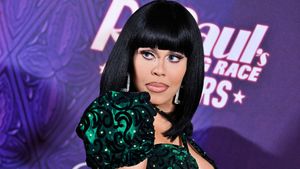Katherine "Kate" Kane -- the buxom billionaire heiress by day and sexy crime fighter Batwoman by night -- is back, returning to comic books with her own series in Detective Comics #854. Oh, and in case you haven't heard by now, she's also a lesbian. "She's out and proud," says the comic's writer Greg Rucka. "The only thing she has to hide is what she's doing at night in costume."
The character of Batwoman was first introduced to the comic book world in 1956 as a romantic sidekick to Batman. But she and DC Comics really made headlines in 2006 when the latest incarnation of the character revealed her sexual orientation in the limited weekly series 52. In the comic, we learn of her past relationship with Det. Renee Montoya, a formerly closeted lesbian who was outed by Rucka back in 2003. Batwoman has rarely been seen since, but she is finally taking center stage with Detective Comics #854, which debuted on June 10 with planned monthly installments for one year.
Rucka, 39, is a popular comic book writer who has been writing stories for legendary heroes for more than a decade, among them DC's Wonder Woman and Marvel's Elektra (Daredevil's lethal lover) and hirsute Wolverine of X-Men fame. Rucka also was key in introducing the lesbian Batwoman to the DC universe three years ago.
"Kate's queer -- period. There is no coming out here," says Rucka. "This isn't an issue of, Oh, how do we do this? DC's wanted to bring back Batwoman as a new character, and she is going to be gay. That was there in the mission statement from the start."
Rucka has teamed up with artist JH Williams III, 43, whose cinematic and innovative anime-inspired drawings, full of moody reds and blacks, have also appeared in Promethea, a mystical series created with The Watchman 's Alan Moore. For Batwoman's latest debut, Rucka and Williams have created a take-no-prisoners warrior woman who is a touch of a daddy's girl at heart. And like many comic book heroines, she is very sexy, an intoxicating redhead on a tricked-out bat cycle, decked out in red boots, billowing cape, and her never-leave-home-without-it bat utility belt. (To fans of the camp classic, I'm sorry to report that she no longer carries a bat purse.)
Rucka and Williams, neither of whom is gay, say they labored to make a character that was nuanced and multidimensional and more than the sum of her sexual preferences. In the first issue she even gets dumped by her lover, who thinks she's out tomcatting around at night -- when, in fact, she's out kicking Gotham ass, not looking for it. "I'm in love with the fact that we are featuring a person who is gay and is the main star of the series, but that we aren't being exploitative in our presentation," says Williams. "We want it to be just matter-of-fact. This is life."
While it's a positive step to see a gay character step out into a principal role, mainstream comic book companies are still struggling to depict greater diversity on their pages. To a large degree the fantasy worlds inhabited by DC Comics and its biggest rival, Marvel (the company behind Spider-Man), are still chock-full of straight white men in tights and spandex-covered women with melon-sized breasts.
Part of this is due to the way in which comic book content has been historically regulated. Through much of the 20th century, the Comics Code Authority, an industry regulatory body, did not allow the depiction of gay characters in comics at all. In the 1950s, reactionary psychiatrist Fredric Wertham wrote a book called Seduction of the Innocent, claiming that comics were filled with violent and sexual content. Ironically, part of the reason that DC introduced Batwoman during this period, says Joe Palmer of the gay comics fan site GayLeague.com, was to give Batman a female love interest to counter Wertham's assertions. Though the rules barring gay characters were overturned in 1989, the number of gay characters has remained pretty slim: LGBT characters have served in the mainstream comics universe principally as sidekicks and villains.
"Neither DC or Marvel are perfect in their mutual track records concerning gay characters," says Palmer. "A lot of fans were upset that the once campy Batwoman was reimagined as a lesbian. Some of these fans were gay men, for whom Batwoman had become some sort of D-list icon."
Though Batwoman faded back into comic book obscurity after generating promising buzz when she came out in 2006, this time, Rucka assures us, she's here to stay.
"She's up front and center and is wearing arguably one of the most visible icons in pop culture ever," says Rucka. "That bat brings in billions of dollars for Warner Bros."


















































































